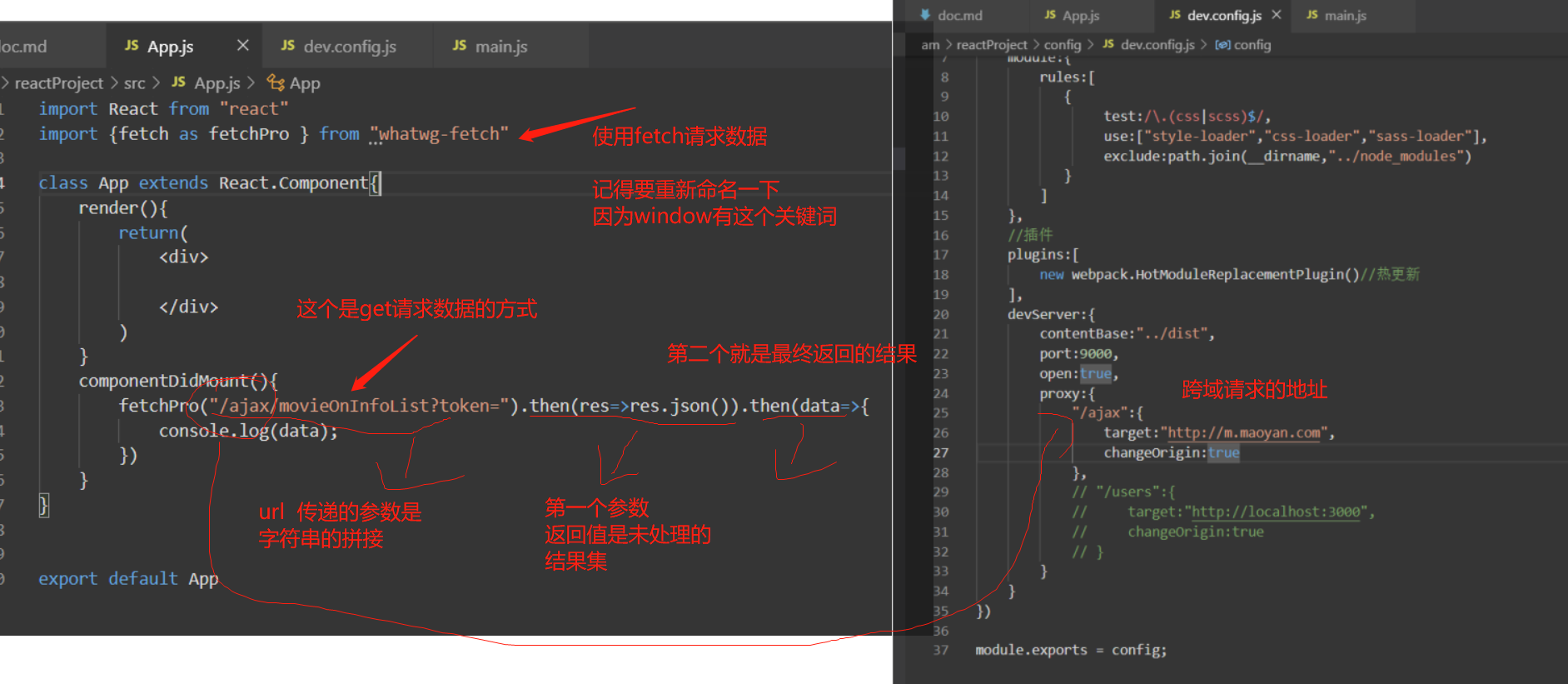这是fetch 请求数据的方式

---fetch---基本使用
一、fetch
fetch是一种XMLHttpRequest的一种替代方案,在工作当中除了用ajax获取后台数据外我们还可以使用fetch、axios来替代ajax
二、安装
执行npm install whatwg-fetch --save即可安装。
为了兼容老版本浏览器,还需要安装npm install es6-promise --save
三、fetch的基本使用
npm install whatwg-fetch --save
npm install es6-promise --save
import 'es6-promise'
import 'whatwg-fetch'
fetch(url,options).then((res)=>{
console.log(res);
},function(err){
console.log(err)
})
说明:
1、fetch的返回值是一个promise对象
2、options
method:HTTP请求方式,默认是GET
body:请求的参数
fetch('/xxx', {
method: 'post',
body:'username=zhangsan&age=17'
});
headers:HTTP请求头
因为一般使用JSON数据格式,所以设置ContentType为application/json
credentials:默认为omit,忽略的意思,也就是不带cookie还有两个参数,same-origin,意思就是同源请求带cookie;include,表示无论跨域还是同源请求都会带cookie
3、在.then里面第一个回调函数中处理response
status(number): HTTP返回的状态码,范围在100-599之间
statusText(String): 服务器返回的状态文字描述
headers: HTTP请求返回头
body: 返回体,这里有处理返回体的一些方法
text(): 将返回体处理成字符串类型
json(): 返回结果和 JSON.parse(responseText)一样
blob(): 返回一个Blob,Blob对象是一个不可更改的类文件的二进制数据
如果请求一个XML格式文件,则调用response.text。如果请求图片,使用response.blob方法
注意:
cookie传递必须在header参数里面加上credentials: 'include',才会如xhr一样将当前cookies带到请求中去
四、get、post请求方式
1、get
var result = fetch('url', {
credentials: 'include',
headers: {
'Accept': 'application/json, text/plain, */*',
},
});
2、post
var result = fetch('/api/post', {
method: 'POST',
credentials: 'include',
headers: {
'Accept': 'application/json, text/plain, */*',
'Content-Type': 'application/x-www-form-urlencoded'
},
// 注意 post 时候参数的形式
body: "a=100&b=200"
});
五、封装get和post方法
1、get
import 'es6-promise'
import 'whatwg-fetch'
export default (url)=>({
var result = fetch(url, {
credentials: 'include',
headers: {
'Accept': 'application/json, text/plain, */*',
},
})
.then(res=>res.json());
return result
})
2、post
import 'es6-promise'
import 'whatwg-fetch'
import qs from 'qs';
export default (url,data)=>({
var result = fetch(url, {
method: 'POST',
credentials: 'include',
headers: {
'Accept': 'application/json, text/plain, */*',
'Content-Type': 'application/x-www-form-urlencoded'
},
// 注意 post 时候参数的形式
body: qs(data)
})
.then(res=>res.json())
return result;
})
六、fetch与axios的区别
axios("http://xxx/xxx.json?a=123'").then((res)=>{
console.log(res)//这里的r是响应结果
})
fetch("http://www.baidu.com").then((res)=>{
console.log(res);//是一个综合各种方法的对象,并不是请求的数据
})
fetch返回的是一个未处理的方法集合,我们可以通过这些方法得到我们想要的数据类型。如果我们想要json格式,就执行response.json(),如果我们想要字符串就response.text()
axios
1、从浏览器中创建 XMLHttpRequest
2、从 node.js 发出 http 请求
3、支持 Promise API
4、拦截请求和响应
5、转换请求和响应数据
6、自动转换JSON数据
7、客户端支持防止CSRF/XSRF
fetch:
符合关注分离,没有将输入、输出和用事件来跟踪的状态混杂在一个对象里
更加底层,提供的API丰富(request, response)
脱离了XHR,是ES规范里新的实现方式
1、fetchtch只对网络请求报错,对400,500都当做成功的请求,需要封装去处理
2、fetch默认不会带cookie,需要添加配置项
3、fetch不支持abort,不支持超时控制,使用setTimeout及Promise.reject的实
现的超时控制并不能阻止请求过程继续在后台运行,造成了量的浪费
4、fetch没有办法原生监测请求的进度,而XHR可以
